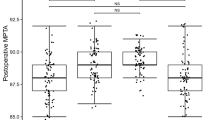Abstract
Purpose
The aim of this study is to evaluate the accuracy of VISIONAIRE (Smith & Nephew Inc., Memphis, TN, USA) Patient Matched cutting tibial jigs in comparison with extramedullary (EM) tibial instrumentation by analysing data as detected by intra-operative use of VectorVision knee navigation software from BrainLAB (Redwood City, CA, USA).
Methods
Twelve patients were selected for unilateral total knee replacement (TKR). They underwent a full-length weight-bearing anteroposterior (AP) radiograph and magnetic resonance imaging (MRI). During surgery, once the EM guides were placed and fixed on the tibia, the orientation in the coronal and sagittal planes was checked by the navigator and then compared with the data obtained by measuring the orientation of VISIONAIRE Patient Matched cutting tibial jigs. An unsatisfactory result was considered an error ≥2° in both coronal and sagittal planes for the tibial component as a possible error of 4° could result.
Results
In the coronal plane the mean deviation of the EM tibial guides from the ideal alignment (0°) was 0.7 ± 0.39° and of the VISIONAIRE was 129 ± 1.55° (P = 0.22). In the sagittal plane the mean deviation of the EM tibial guides from 3° of posterior slope was −1.62 ± 1.78° and of the VISIONAIRE was +1.16 ± 4.29° (P < 0.05). Negative values indicate a more posterior slope from the ideal and positive values an anterior slope.
Conclusions
This preliminary study documented only a fair accuracy of the method with a consistent risk of error of more of 3° especially in the sagittal plane. We could speculate that the problem in the sagittal plane was due to the fact that the pre-operative protocol does not include a lateral X-ray projection of the knee and only includes an AP standing X-ray of the straight leg and MRI.




Similar content being viewed by others
References
Lundblad H, Kreicbergs A, Söderlund V, Ulfgren AK, Stiller CO, Jansson KA (2011) The value of preoperative grade of radiographic and histological changes in predicting pain relief after total knee arthroplasty for osteoarthritis. Knee Surg Sports Traumatol Arthrosc. [Epub ahead of print]
Ishida K, Matsumoto T, Tsumura N, Kubo S, Kitagawa A, Chin T, Iguchi T, Kurosaka M, Kuroda R (2011) Mid-term outcomes of computer-assisted total knee arthroplasty. Knee Surg Sports Traumatol Arthrosc 19(7):1107–1112
van der Linden-van der Zwaag HM, Bos J, van der Heide HJ, Nelissen RG (2011) A computed tomography based study on rotational alignment accuracy of the femoral component in total knee arthroplasty using computer-assisted orthopaedic surgery. Int Orthop 35(6):845–850
Magnussen RA, Weppe F, Demey G, Servien E, Lustig S (2011) Residual varus alignment does not compromise results of TKAs in patients with preoperative varus. Clin Orthop Relat Res 469(12):3443–3450
Hernández-Vaquero D, Suarez-Vazquez A, Iglesias-Fernandez S (2011) Can computer assistance improve the clinical and functional scores in total knee arthroplasty? Clin Orthop Relat Res 469(12):3436–3442
Rottman SJ, Dvorkin M, Gold D (2005) Extramedullary versus intramedullary tibial alignment guides for total knee arthroplasty. Orthopedics 28(12):1445–1448
Jenny JY (1999) Influence of intramedullary versus extramedullary alignment: guides on final total knee arthroplasty component position by Antonio Maestro et al. (pp 552–558). J Arthroplasty 14(7):898–899
Yang SH, Liu TK (1998) Intramedullary versus extramedullary tibial alignment guides in total knee arthroplasty. J Formos Med Assoc 97(8):564–568
Tigani D, Masetti G, Sabbioni G, Ben Ayad R, Filanti M, Fosco M (2012) Computer-assisted surgery as indication of choice: total knee arthroplasty in case of retained hardware or extra-articular deformity. Int Orthop. [Epub ahead of print]
Cheng T, Zhao S, Peng X, Zhang X (2011) Does computer-assisted surgery improve postoperative leg alignment and implant positioning following total knee arthroplasty? A meta-analysis of randomized controlled trials? Knee Surg Sports Traumatol Arthrosc. [Epub ahead of print]
Blakeney WG, Khan RJ, Wall SJ (2011) Computer-assisted techniques versus conventional guides for component alignment in total knee arthroplasty: a randomized controlled trial. J Bone Joint Surg Am 93(15):1377–1384
Brin YS, Nikolaou VS, Joseph L, Zukor DJ, Antoniou J (2011) Imageless computer assisted versus conventional total knee replacement. A Bayesian meta-analysis of 23 comparative studies. Int Orthop 35(3):331–339
Seon JK, Park SJ, Lee KB, Li G, Kozanek M, Song EK (2009) Functional comparison of total knee arthroplasty performed with and without a navigation system. Int Orthop 33(4):987–990
Ishii Y, Ohmori G, Bechtold JE, Gustilo RB (1995) Extramedullary versus intramedullary alignment guides in total knee arthroplasty. Clin Orthop Relat Res 318:167–175
Dennis DA, Channer M, Susman MH, Stringer EA (1993) Intramedullary versus extramedullary tibial alignment systems in total knee arthroplasty. J Arthroplasty 8(1):43–47
Hafez MA, Chelule KL, Seedhom BB, Sherman KP (2006) Computer-assisted total knee arthroplasty using patient-specific templating. Clin Orthop Relat Res 444:184–192
Klatt BA, Goyal N, Austin MS, Hozack WJ (2008) Custom-fit total knee arthroplasty (OtisKnee) results in malalignment. J Arthroplasty 23(1):26–29
Spencer BA, Mont MA, McGrath MS, Boyd B, Mitrick MF (2009) Initial experience with custom-fit total knee replacement: intra-operative events and long-leg coronal alignment. Int Orthop 33(6):1571–1575
Noble JW Jr, Moore CA, Liu N (2012) The value of patient-matched instrumentation in total knee arthroplasty. J Arthroplasty 27(1):153–155
Author information
Authors and Affiliations
Corresponding author
Rights and permissions
About this article
Cite this article
Conteduca, F., Iorio, R., Mazza, D. et al. Are MRI-based, patient matched cutting jigs as accurate as the tibial guides?. International Orthopaedics (SICOT) 36, 1589–1593 (2012). https://doi.org/10.1007/s00264-012-1522-9
Received:
Accepted:
Published:
Issue Date:
DOI: https://doi.org/10.1007/s00264-012-1522-9




